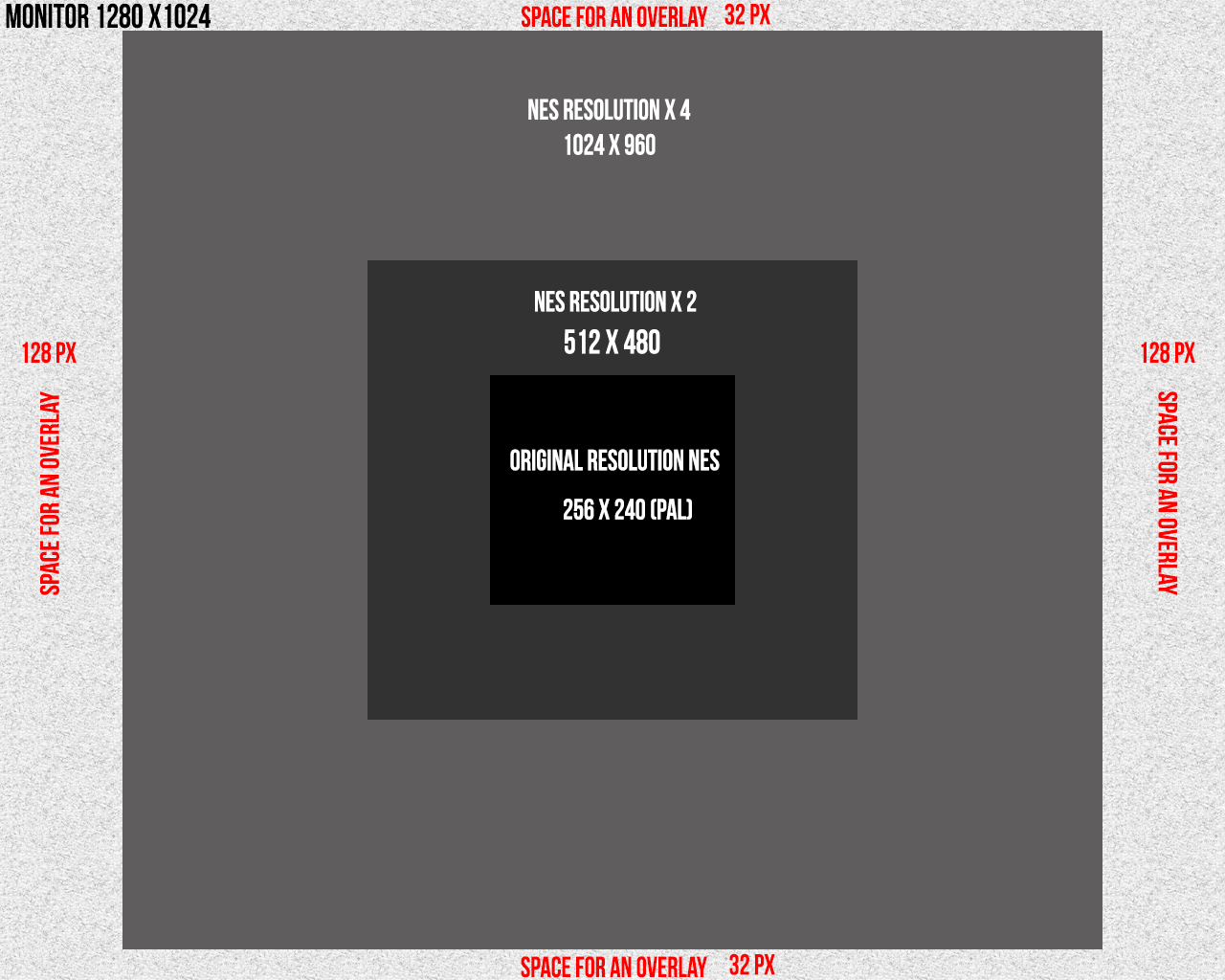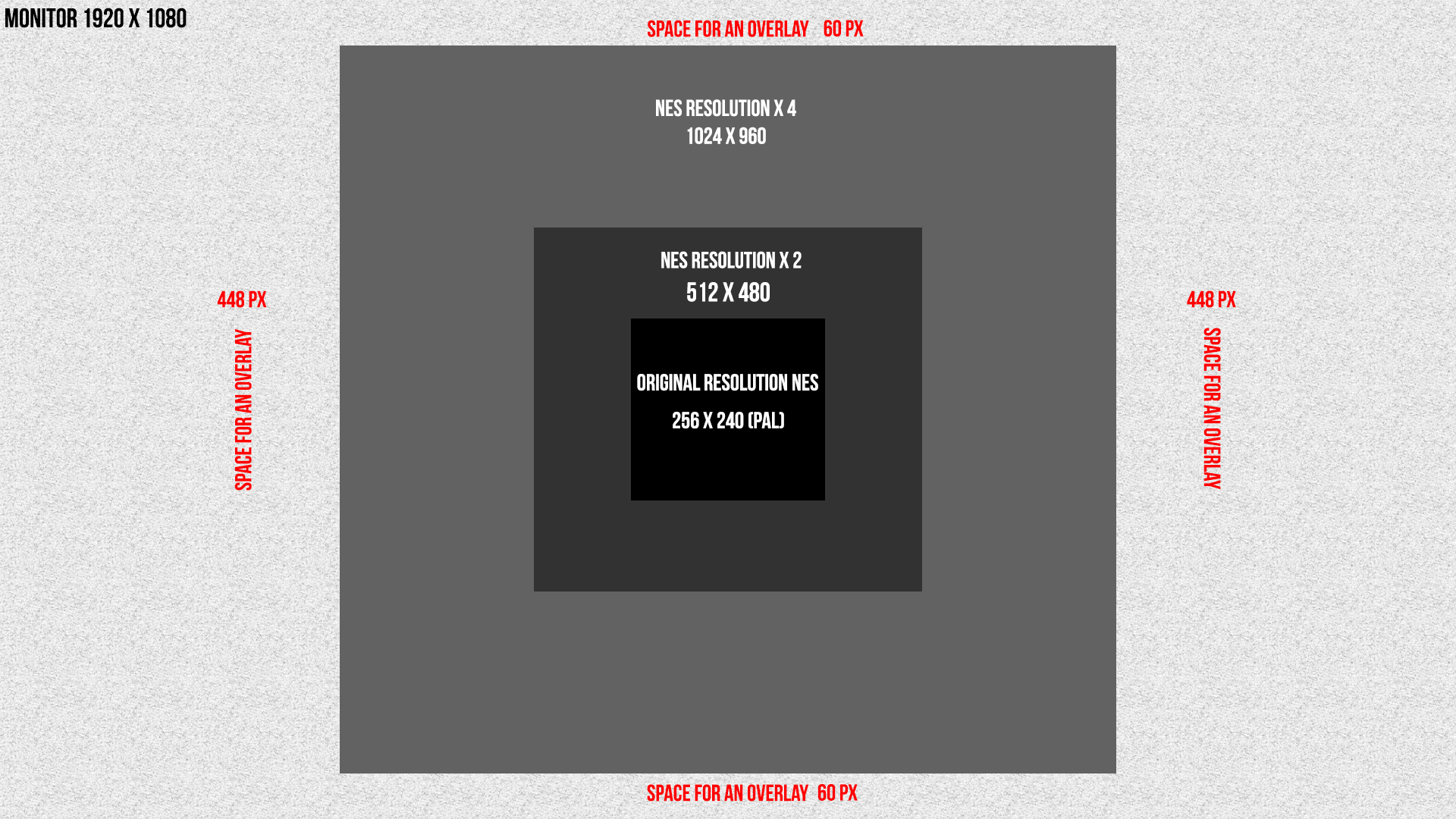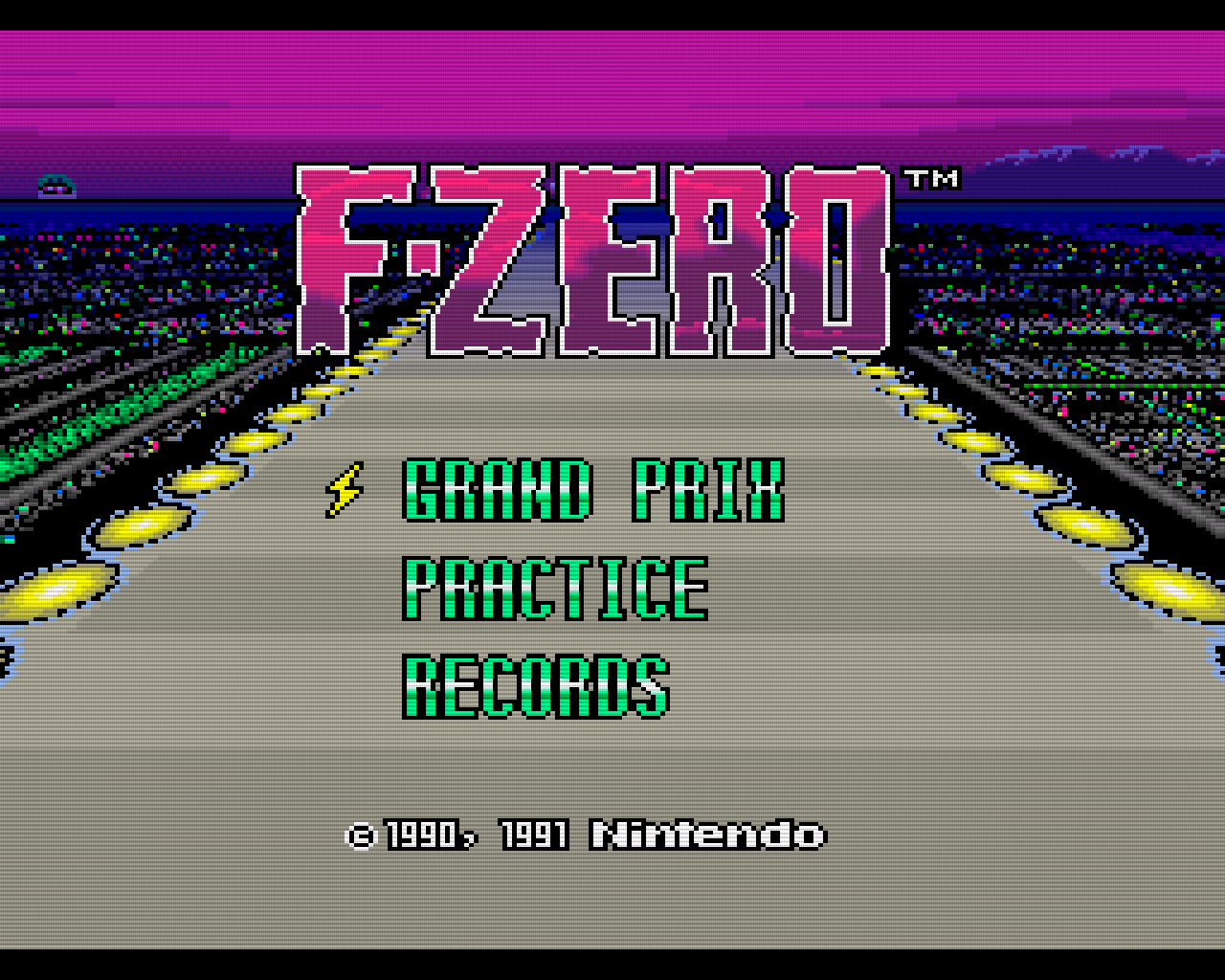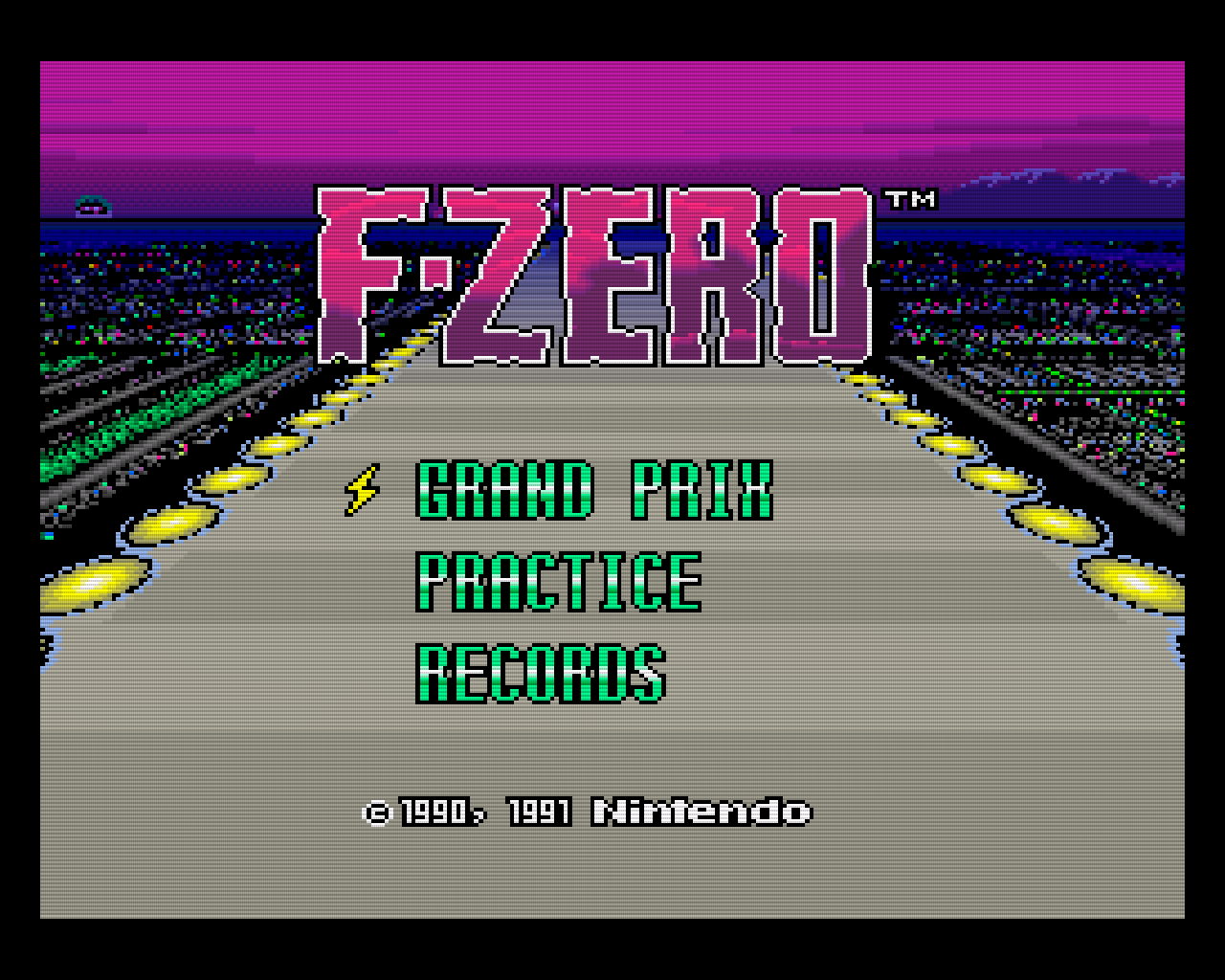Overlays
-
@subs, yes. With a resolution of 1280x1024, overlays only make sense, if Pixel Perfect is activated. Otherwise the space to be used won't be any good for an overlay.
Here is a s**tload of Arcade overlays
And HERE are some more
and a WHOLE DB

-
@subs
so if i get you right : for 5:4 monitors, overlays are only useful for vectrex, vertical games or when integer scale is activated ?Yes for me but some people would be interested to have overlays on 5:4.
No integer scale is used, you need to fit the emulated area to the free area of the overlay, manualy.
(Don't forget, pixels aren't square).
All Overlays have differents size to show emulated screen.
(Or you must standardized all overlays).For Bezels (i repeat, a bezel is a overlay frame), no need to upscale or downscale.
If you use a 1280x720 bezel on a 1920x1080 resolution, it will fit perfect. RetroArch upscale nicely.
And if you use a 1920x1080 bezel on a 1280x720 resolution, it will fit perfect. RetroArch downscale nicely.1920/1080 = 1280/720 = 1.77 ratio
-
@ironic a usual game screen is more or less 4:3, which leaves hardly any space for an overlay on a 5:4 monitor. Put it another way : 1280x1024 monitors hardly have any space left for any decent overlay as there are almost no pixels left on the screen that are not the emulator viewport. That's why I thought overlays are only interesting when integer scale is activated on 1280x1024.
Your double dragon screenshot is the perfect example of what I'm trying to say :
- if integer scale was off, there would hardly be any space left for the overlay
- with integer scale, you get a little more space
So why bother when there is no integer scale ? I don't think people would appreciate that we reduce the viewport (even if we keep the original game ratio) whereas without overlays they had an almost fullscreen game. That's my understanding of it, let's share opinions

-
Like this? NES (PAL) with PP activated (?)

-
And here's the 1080p version

-
Ratio...
TV/Arcade monitor is 4/3 (4/3 = 1.25).If you take NES resolution, you can see :
256/240 = 1.06 !!? ?
Where is 4/3 ?
Pixels aren't square on NES, SNES...With your *4 resolution on X and Y :

On Megadrive, some games are 320x240, so
320/240 = 1.33 Here is 4/3 square pixels.If you take you NES RESOLUTION X4 FRAME, you can see, there is not 4/3 ration.
But if you use 4x256 and 3x240 (1024x720) there is a 4/3 ratio.

Double Dragon with integer scale and 4/3 Ratio on my Double Dragon Bezel

Big waste of space.This is my resolution for Double Dragon.
Ok it isn't 4/3 ratio but it's for try to fit the Bezel.

If everybody wants Integer Scale + 4/3 Aspect Ratio + all Bezels + for all consoles + for all monitors + for all resolution.
It will be a hard job.
But this post is here to find a solution. -
Humm poor Ironic...
If you take you NES RESOLUTION X4 FRAME, you can see, there is not 4/3 ration.
But if you use 4x256 and 3x240 (1024x720) there is a 4/3 ratio.
No, no and no. 1024/720 = 1.42
4/3 = 1.33
Sorry... -
@ironic i dont understand ...
no one said all emulators have a 4:3 ratio.
NES is 16:15
SMS is 4:3
GBA is 3:2
GB and GBC are 10:9
And as far as i remember, double dragon is 15:14 (indeed, it's 240x224 -> ratio of 1.07)How does retroarch stretch then ? Does it stretch to simulate a 4:3 screen, so that, indeed, no pixels are square (but SEGA) ? Or does it simply multiply X and Y byt the same factor, keeping the original ratio, having square pixels, but not simulating an 4:3 output ?
I'm at work, can't experiment for now ..... But i'd say square pixels, so it keeps the original ratio. The double dragon example proves it
-
NES is 16:15 ratio ?
Never.
NES screen is done to be seen on a 4/3 CRT in full screen, so NES is 4/3 Aspect Ratio.Wiki :
The aspect ratio of an image describes the proportional relationship between its width and its height256/240 (or 16/15 ) is not the Aspect Ratio.
This is a NES screen (256x240) X4 so 1024*960

Do you thin aspect ratio is correct ?This is a true 4/3 aspect ratio of a NES screen.

It is pixel perfect (or integer scale on) so the scanline is perfect.
This is a 4x5 screen (1280x960) but the result is 4/3 screen.Pixels are not square on TV, NES and others plateformes.
Double Dragon is made to be seen on a arcade monitor, a 4/3 screen in fulsscreen.
So is aspect ratio is 4/3 but not X pixels/Y pixels.CPS1 games have 384x224 resolution. 384/224 = 1.71 !!
Is done to be seen on a 4/3 screen. 4/3 = 1.33 !!
Why ? Pixels are not square.Never mind the resolution
A game is done to be seen on a 4/3 screen in full screen ??
Yes !
Ok, this game (256240, 320240, 256192, 384224...never mind....) is 4/3 aspect ratio. -
just tried Mario. The core scales the game to 1440x1080 on a 1080p screen. Which means it was upscaled in 4:3. In other words, any console meant to be played would have the same fullscreen viewport ? I tried with SMS, NeoGeo, SNES : always the same viewport size. Which makes things rather easy for non PP display
So the question now is to calculate the screen size when PP is activated
a little reading : http://libretro.com/forums/showthread.php?t=1471&p=15087&viewfull=1#post15087
-
just tried Mario. The core scales the game to 1440x1080 on a 1080p screen. Which means it was upscaled in 4:3. In other words, any console meant to be played would have the same fullscreen viewport ?
- YES.
But is you activate Integer Scale, the size would be : 1280x960
NES pixels are X=1,25 for Y=1
(2561.25=320 2401 = 240 320/240 = 1.33 = 4/3)
On your link, you can see all consoles use 240 pixels (vertical) but not all viewport is used.
SMS use only 256x192 but the resolution is 256x240.Your link talks about non-square pixel.
There is a lot resolution and lot of game console, so we must only try to respect 4/3 format on your monitor.
3/4 for Arcade vertical games.For best image quality, we must use Integer Scale.
(PP or Pixel Pefect can be used only with square pixel).For all 4/3 games, we must use :
On 1280x1024 monitor => 1280x960 resolution.
On 1280x720 monitor => 960x720 resolution.
On 1920x1080 monitor => 1280x960 resolution.
(LCD pixels aren't exactly square, lets forget that).But...
Everything I have said is false
Resolution is 240 (vertical) but only 224 pixels are displayed.So...
The real aspect ratio of a game is 4/3 in fullscreen.
The displayed pixels area is 256x224 ou 320x224 ou 384x224...On a fullHD (with Perfect Pixels) the screen with Integer Scal must be :
(Vertical) 1080/224 = 4.82 (keep 4).
2244 = 896
896/34 = 1194.6 (keep 1194)
X = 1194 and Y = 896On my 1280x1024 5/4 monitor.
1024/224 = 4.57
2244 = 896
896/34 = 1194.6 (keep 1194)
X = 1194 and Y = 8964/3 = 1.333333......
1194/896 = 1.3325....This is (for me) the "perfect way" to display a NeoGeo (or other 4/3) game on a 5/4 LCD monitor.


- 4/3 screen (320x224 upscaled).
- Scanlines Shader is perfect
For those who say, the honrizontal scale is not an integer scale, i answer :
Remember the PAL/NTSC resolution.
NTSC (525 lines fo 720 × 480) PAL (625 lines for 720 × 576).On hi resolution, 1280x1024 or 1920x1080, we can use non-integer scale, 99% of people never seen the non-integer pixels.
Without scanline, nothing is visible.All these "equations" gives a headache ? Sure...
But what we (you) want to do ?This post is for Overlays but for perfect overlays, a screen ratio must be definied.
- YES.
-
@ironic all of your posts give such a headache lol But at least we move forward

But if i want to sum up what you wrote :
- we need to keep the 4:3 ratio for consoles
- it's only worth with integer scale
- The integer scale resolution is the same for any console, but must be calculated according to the screen resolution :
- 1080p : 1280x960
- 5:4 (DMT 35 1280x1024) : 1280x960 too
- 720p : 960x720
I guess that sets it for consoles ?
If so, here are the margins left for each mode :
- 1080p : top/bottom : 60px, left/right : 320px
- 1280x1024 : top/bottom : 32px, left/right : 0px
- 720p: top/bottom : 0px, left/right : 160px
1080p has space left everywhere
720p just has 160px left on left as well as on right => we can't let retroarch shrink a 1080p overlay
1280x1024 as 32px left on top as well as on bottom => worthlessWhat about arcade (forget NeoGeo) ? Looks like those rules fail as we can't set a generic viewport : Mame handles the real resolution of games, and nothing is stretched to 4:3 unless forced or native ? That would mean a per game viewport
One more thing : i thought PP and IntegerScale are the same ... but no ? PP is when we strictly respect the original resolution without stretching it to fit 4:3 ?
-
I dont agree with this: The integer scale resolution is the same for any console,
-
@supernature2k indeed you are right ... As it depends on the native console resolution stretched to 4:3
-
@supernature2k @subs
Here are the screenshots, we were talking about earlier:
System: SNES
Monitor: 19" TFT LCD
Connection: HDMI -> DVI
TV Mode: DMT 35 DVI
Game: F-ZERO
Screenshots: raspi2pngOption 1
Shader: Scanlines
Integer Scale: OFF
Smooth: ON
Ratio: Auto

Option 2
Shader: Scanlines
Integer Scale: ON
Smooth: ON
Ratio: Auto

-
I don't want to bother you... What you are doing seem very complicated to mee ^^
But maybe I can help you.
UXS can now generate Picture with Resolution and Ratio configuration.
Maybe it can scrape a picture dedicated to overlay.Something basic with wheel or Marquee (maybe 3D or 2D Box) but autogenerated for every game (Console & Arcade)
(Just to let you know this is thing UXS can do in a very near futur : Teaser )
-
@subs
All you wrote is ok.
If we want to use overlay all around the game screen, it's better to use Interger Scale.
But if we want bigger or thinner overlay, we must disable Interger Scale.
As several consoles haven't square pixels, we must disable Integer scale.First, we must do a choice. What do we want ?
- The best quality with vertical integer scale ?
- The bigger screen with 4/3 ratio respect ?
- The more space possible for overlay ?
Is the overlay will be enabled game by game ?
Or console by console ?I don't know what people wants.
Most people are not interested in all that we say here. They just want nice quality games and fun.For Arcade games, is more difficult.
There's several resolution but we can keep 4/3 aspect ratio (or 3/4).Another problem is RetroArch crop the game screen.
Some NeoGeo game use 320x224 and other 304x224 but RetroArch resize the screen.
Some game (like Sega M.S.) have a "no pixel area border" on left.I think we must define a generic viewport of 4/3 with enough space for overlay.
Pixel Perfect and Integer Scale are 2 differents things (for me).
Integer Scale means that all honrizontal pixels have same size, all vertical pixels have same size,
But honrizontal size and vertical size of a pixel can be different.
On my Bartop, one NES pixel is 5 native pixels (honrizontal) and 4 native pixels (vertical).Pixel Perfect means all pixels have same size, honrizontal = vertical.
Pixels are square.Recalbox wiki say Integer Scale = Pixel Perfect.
Why not. It's ok for me. But i prefer use Interger Scale.
Pixel Perfect is for browser or photoshop users...@screech
Yes, it's very complicated.
Shall we try and compare quality overlays.
I will try your new UXS soon... -
This is how I see things according to what I've understood so far :
- overlays without integer scale is as easy as killing babies with axes : consoles (not handheld) will be stretched to max size (which is screen height * 4/3). Handhelds are natively pixel perfect, so it's the same story almost. Any overlay for non IS game will just fill a pair of side borders
- using overlays on 1280x1024 screens is worthless but for vertical shmup
- I still think overlays are much more worth when integer scale is on
- handheld consoles should be easy for there IS screen resolution
- nothing is set yet on how to manage arcade
- the aim os to make some overlay models for each console, for a few different screens, even if i think 1080p and 720p are the only worth ones
- integer scale is, as i understood, the fact of multiplying both the emulator resolution by a single integer. It has no impact on scaling the video to 4:3
- for arcade, i think we should keep the original rom resolution (or smhumps would be stretched) => Pixel Perfect mode for arcade. One of my next tasks for arcade is to list all mame supported games with their resolution. Haven't checked yet how it is stored on fba
Of course, this is my personnal opinion. I think we put things plain, time to decide ^^
For consoles, based on the link i posted earlier on the libretro forum, this is what i suggest as resolutions :
- SNES : 299x224
- Megadrive : 299x224
- NES : 299x224
- SMS : 256x192
- FDS : 299x224
- NeoGeo : 299x224 (though i wonder, looks like it crops the image)
-
299/224 = 1.3348
It's the nearest 1.3333 CRT (4/3) aspect ratio.If our monitors have a square pixel, everything is good.
If the pixels are not square, we must recalculate the resolution.On my LCD1280x1024 IBM ThinkVision 17 "5/4:
X = 340mm
Y = 271mm340/1280 = 0.265
271/1024 = 0.264
A pixel is 0.26mm x 0.26mmWe can say that the pixels are square.
Somebody can calculate pixel size on 16/9 monitor?Various resolutions will be used:
1280x1024, 1280x720, 1920x1080The basis for the resolution is 4/3 of 299/224.
With a vertical Integer Scale and the largest image:1280/1024:
299/224 × 4 = 1196x896

1280 * 720:
299/224 x 3 = 897x672

1920/1080:
299/224 × 4 = 1196x896

With this resolution, image quality will be the best, with and Without scanline shader.
And give area for an overlay.Arcade games resolution and other:
Arcade Infos GamesFor arcade games, overlays are very differents. It's impossible to set a resolution.
Each game must have his resolution. -
Very nice job ironic.
Concernning lcd monitors square pixels, let it be a dogma : they are square, can't bother for every recalboxer ...
For arcade, as I said earlier, the aim of the topic is to go step by step, and find some rules and scales for overlays. I'd love to offer some masks (png / psd) for people (like @screech) who want to generate overlays
so far we haven't spoken yet of handhelds, but they all have a lcd screen, just need to find their resolutions, and their integer scale values for 1080p and 5:4
@ironic the SMS is the only one with a resolution different from 299x224 : 256/192, which is 4/3. So this perticular overlay should be slightly different than others. We also means quite some consoles, namely vectrex as you've worked quite much on its overlays
As, quite often, most consoles have several resolutions, should we force a 4/3 custom ratio in retroarch or can wa consider afterall that those consoles would anyway render to 299x224 ?
For the pixel aspect ratio of any screen : you can do it much faster. The panel size ratio MUST equal the resolution aspect ratio.
In yur case, you just pray that 340/1280 = 271/1024 => 1280/1024 = 340/271. 5/4 = 1.25, 340/271 = 1.262Anyway, no need to check monitors, that's a user problem that we can't solve through recalbox as it depends on parameters (the real lcd panel size) that we can't programmatically get.
